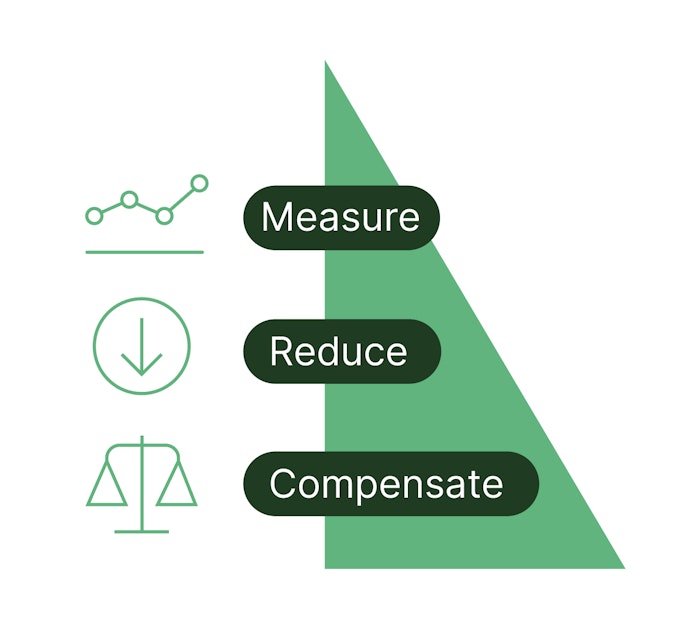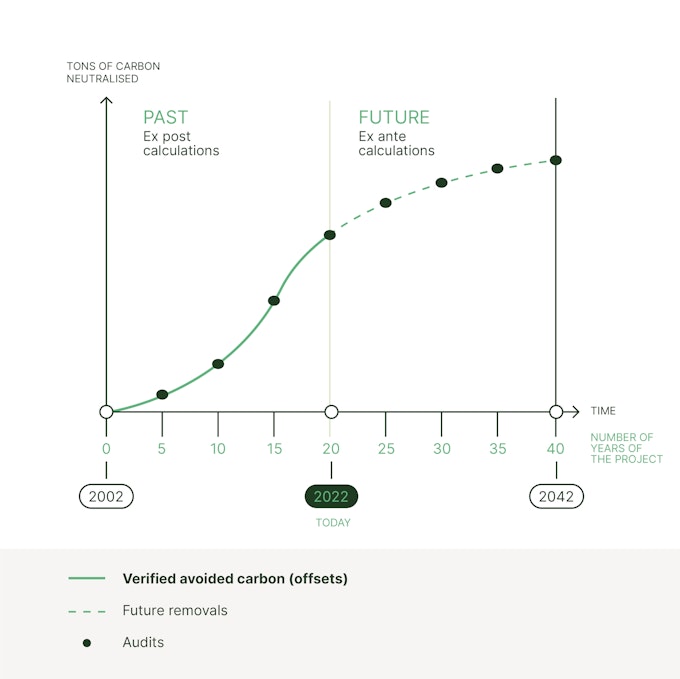What is a carbon offset?
So, what is a carbon offset?
A carbon offset is any activity certified to compensate for carbon dioxide (CO2) and other Green House Gas (GHG) emissions released to the atmosphere by either removing them or avoiding them in the first place. There are two means by which an offset can achieve this: avoidance of emissions and removal of emissions.
Firstly, the avoidance of emissions can be achieved in the following ways:
- Ensuring carbon that is already stored and inert remains so, such as through protecting existing peat bogs or forests susceptible to being degraded.
- Preventing emissions from reaching the atmosphere by capturing them before they are released, such as by installing carbon capture technologies in a factory.
- Preventing the release of emissions in the first place, such as through the use of renewable energy sources where they can be demonstrated to displace existing or new fossil fuels sources.
This is sometimes also referred to as emissions reduction, in so far as that the offsets quantifiably reduce the amount of emissions that would otherwise be released in a given project location, as compared with a baseline scenario where the offset project has not taken place.
Secondly, the removal of emissions involves taking down carbon already present in the atmosphere and can be done through:
- Nature-Based Solutions (NBS) including afforestation and reforestation projects, as well as restoration projects that result in the removal of CO2 from the atmosphere like a peatland restoration.
- Engineered solutions such as Direct Air Capture with Carbon Storage (DACCS) and enhanced weatherization of minerals.
Other synonyms used for “removal” in the context of carbon offsets are absorption, sequestration, and capture. There is an argument for limiting what counts as a carbon offset exclusively to those falling under the category of carbon removal. This is for two reasons: the need to draw carbon out of the atmosphere in order to compensate for continued and increasing carbon emissions elsewhere; and because of concerns about the price of offsets becoming too low in the long term to disincentive carbon-emitting activities if market limits are not placed on what constitutes a valid offset.

Although something may qualify as a carbon offset if it falls into either of these categories of offset, there is more to take into consideration to identify whether an offset is good or not. As we will see in the next article in this series, ultimately, a worthwhile offset has to diminish the total amount of carbon in the atmosphere in a demonstrable and reliable manner.
As illustrated above, carbon offsetting projects can be based on a range of technologies as long as they can prove that they neutralise carbon emissions through either avoidance or removal (examples we mentioned go from renewable energy to forestry, from nature-based to engineered solutions). They must be certified by an adequate third-party organisation, such as Verra or The Gold Standard, which can be done according to different methodologies used to quantify the emissions captured or avoided.
These projects are generally funded by commercialising carbon offsets. Carbon offsets are by design measurable units generated by carbon offsetting projects. They are typically measured in metric tonnes of 'CO2 equivalent' (CO2e) captured or avoided and normally result in the issuance of carbon credits (which are an instrument that represents the ownership of one tonne of CO2e avoided or removed; a carbon offset usually generates a carbon credit, but some carbon credits issued by standard organisations do not necessarily come from carbon offset projects).
Individuals and organisations can purchase carbon offsets as part of their efforts to achieve Net Zero, which mostly falls under the ‘Voluntary’ offset category, as opposed to the organisations that are legally required to offset their emissions (‘Compliance’ offsets).
Mitigation hierarchy: measure, reduce, and then offset
If you are choosing to offset your emissions, what should you look for?
Offsetting is about more than just the implementation of offsetting technologies such as those mentioned above and should follow something called the Mitigation Hierarchy. This is a method widely adopted by organisations as a means to take steps to reduce emissions from their activities wherever possible before dealing with so-called residual emissions that cannot be immediately reduced or eliminated.
While there are various ways in which the hierarchy can be presented, they all have the same basic structure. As can be seen from this simplified representation, compensating for emissions through purchasing carbon offsets only constitutes the last step of this approach:
- Measure: collect data that accurately reflects an organisation’s Scope 1,2 and 3 GHG emissions.
- Reduce: design and implement an effective strategy for avoiding (and therefore reducing) emissions where possible.
- Compensate: purchase high-quality carbon offsets or future removals (as we will explain in the following paragraphs) for any remaining, unavoidable GHG emissions.
All three of these approaches make up an effective carbon mitigation strategy and are all necessary means of avoiding the worst consequences of climate change.

Distinguishing offsets from future carbon removals
Beyond the different types of offsets mentioned above, another key factor to consider when supporting certified carbon compensation projects is timing, namely when the CO2 avoidance or removal takes place. We will use the terms offsets and future removals to distinguish the two main options available in the market to neutralise emissions already present in the atmosphere.
Carbon offsets
These refer to emissions that have already been verified as avoided or removed through a given certified offset project. Ex post calculations estimate the carbon compensation (either by carbon avoidance or removal) up to the moment when the calculation is made and must be performed on a regular basis. These calculations are based on actual project figures using an approved methodology. Carbon offsets normally result in the generation of carbon credits as the project’s performance in terms of CO2 compensation is verified.
Technically speaking, the concept “offset” should only be used when the carbon compensation (either by removing or avoiding) has already taken place and has been verified in the context of the official certification standard the project abides by. While carbon offsets occur in both avoidance and removal projects, the following diagram depicts the offset concept and ex-post calculations in carbon avoidance projects.

Future carbon removals
In this situation, the project is financed in the present, but the carbon sequestration takes place in the future. This is typically the case for afforestation projects, which are developed and funded upfront under the promise (and commitment) that they will sequester carbon throughout the project’s lifetime (and sometimes beyond).
The potential amount of CO2 that a project will remove in a given period is estimated through ex-ante calculations i.e. performed before the removals have actually taken place. For afforestation projects, it is calculated by measuring the absorption capacity, over time, of the tree species used and multiplying by the number of units of each species.
We use the term "future removals" rather than “future offsets” for two reasons: 1) the carbon impact will always be in the form of carbon removal (not avoidance); 2) the term offset refers only to verified past offsets.
To stimulate the development of this sort of project, in some countries a percentage of the potential offset calculated (e.g. in Spanish afforestation 20%) is turned into carbon credits in advance and can then be declared on an organisation's balance sheet before the actual compensation takes place. The remaining credits are issued as the amount of carbon it has absorbed is verified based on ex-post calculations. At Reforestum, we use what we call Forest Shares to incentivise investment in carbon absorption forestry projects and to make them more tangible and understandable to society.
Although these projects may be used to neutralise past emissions, it is very important to note that they actually remove CO2 in the future as the forest grows. This implies that even if emissions are considered neutralised, they will be contributing to global warming over a long period of time. Therefore, from a consistent and responsible point of view, it is convenient to invest in future removals so that they meet future emissions at a later point in time, which is typically the case for net-zero strategies.
The following diagram shows the concept of future removals in the only type of carbon offset projects in which they can take place: carbon removal projects. The concepts of carbon offsets, ex-post calculations, and ex-ante calculations are also depicted.

The Reforestum approach
Reforestum works with organisations and individuals who recognise and wish to mitigate the impact their activities have on the climate. The clearest way for them to take action today regarding the last part of the Mitigation hierarchy explained above, is to neutralise some or all residual emissions by supporting projects in the voluntary offset market (which for the first time surpassed $1 billion of market value globally in size last year), as well as to engage with their stakeholders around climate positive action.
NBS (Natured-Based Solutions)
Reforestum wants to go beyond simply capturing CO2 from our environment and that is why it offers Nature-based solutions that protect and nurture biodiverse ecosystems, preventing their extinction and helping them to flourish.
NBSs are defined as “actions to protect, sustainably manage and restore natural and modified ecosystems in ways that address societal challenges effectively and adaptively, to provide both human well-being and biodiversity benefits” according to the IUCN (International Union for Conservation of Nature). That is to say, they constitute an approach to offsetting that acknowledges the broader systemic context in which climate change is occurring, aiming not only to avoid global warming but to preserve the quality and dignity of life in general.
Moreover, NBSs are considered to be a very scalable and cost-effective way to fight against climate change and biodiversity loss. Most NBSs are forestry projects that could be funded through the commercialisation of carbon credits in the voluntary carbon markets.
Reforestum’s NBS portfolio offers both avoidance offsets - in the form of conservation and restoration forestry and peatland projects - as well as future removals- in the form of afforestation and reforestation projects. Some key differences in terms of impact between those different projects are explained here.
At Reforestum, we only invest in projects that make a clear, science-based contribution to reaching Net-Zero by 2050 as required by the Paris agreement, and projects that contribute wherever possible to restoring ecosystems and further empowering the local communities that they rely on more generally.
Educating and raising Awareness
Perhaps one of the highest leverage forms of offsetting carbon is to support and promote education in both carbon emissions avoidance and removal, from how individuals can effectively reduce their emissions to how organisations can neutralise their emissions.
By helping to clarify concepts such as ‘What is a carbon offset?’ and through proper use of language to avoid ambiguities, Reforestum aims to equip organisations and individuals to make informed decisions in relation to their contribution to climate change, ultimately with a view to facilitating the changes in behaviour that will be required to restore our ecosystems to balance.
At this point, it is important to put together the Reforestum's use of offset-related terminology:
- We utilise 'offset' and 'compensate' as synonymous terms and they refer to verified past carbon avoidance or removal.
- We use the term 'neutralise' or 'neutralisation' in a broader sense: they can involve both past offsets and future removals. So, with the claim “neutralise your flight’s footprint” we are referring to financing any type of projects on our platform. The timing element associated with the project will define whether this neutralization takes place instantaneously or over the project lifetime (future removals)
- Both offsets as carbon credits (coming from either avoidance or removal projects) and “future removals” in the form of Forest Shares are understood as environmental assets acquired as an outcome of providing financial support to projects on our platform. While we think making this distinction is critical, we see distinct benefits with both types of climate action and refer to them collectively as environmental assets.
- By carbon, we normally refer to CO2 equivalent (CO2e), which is the metric used to compare the emissions from various GHG on the basis of their global-warming potential.
Finally, we must not forget to mention that carbon offsets are nowadays in the spotlight, as there are arguments pointing out that they, rather than protecting the planet, are causing negative environmental and social effects. However, we believe that these undesirable consequences are due to misuse of these environmental assets and that carbon neutralisation is crucial in solving the climate problems as well as an ineluctable part of the decarbonisation challenge.
As mentioned in the mitigation hierarchy before: offsets should never be used as a substitute for decarbonising the economy or to allow corporations to carry on with GHG emissions that are avoidable in the first place.
Feel free to send us any feedback you have at info@reforestum.com!





